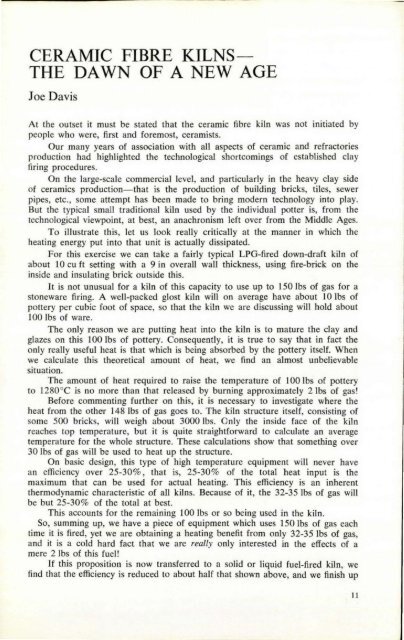Pottery in Australia Vol 17 No 1 Autumn 1978
You also want an ePaper? Increase the reach of your titles
YUMPU automatically turns print PDFs into web optimized ePapers that Google loves.
CERAMIC FIBRE KILNS <br />
THE DAWN OF A NEW AGE<br />
Joe Davis<br />
At the outset it must be stated that the ceramic fibre kiln was not <strong>in</strong>itiated by<br />
people who were, first and foremost, ceramists.<br />
Our many years of association with all aspects of ceramic and refractories<br />
production had highlighted the technological shortcom<strong>in</strong>gs of established clay<br />
fir<strong>in</strong>g procedures.<br />
On the large-scale commercial level, and particularly <strong>in</strong> the heavy clay side<br />
of ceramics production-that is the production of build<strong>in</strong>g bricks, tiles, sewer<br />
pipes, etc., some attempt has been made to br<strong>in</strong>g modern technology <strong>in</strong>to play.<br />
But the typical small traditional kiln used by the <strong>in</strong>dividual potter is, from the<br />
technological viewpo<strong>in</strong>t, at best, an anachronism left over from the Middle Ages.<br />
To illustrate this, let us look really critically at the manner <strong>in</strong> which the<br />
heat<strong>in</strong>g energy put <strong>in</strong>to that unit is actually dissipated.<br />
For tbis exercise we can take a fairly typical LPG-fired down-draft kiln of<br />
about 10 cu ft sett<strong>in</strong>g with a 9 <strong>in</strong> overall wall thickness, us<strong>in</strong>g fire-brick on the<br />
<strong>in</strong>side and <strong>in</strong>sulat<strong>in</strong>g brick outside th is.<br />
It is not unusual for a kiln of this capacity to use up to 150 Ibs of gas for a<br />
stoneware fir<strong>in</strong>g. A well-packed glost kiln will on average have about 10 Ibs of<br />
pottery per cubic foot of space, so that the kiln we are discuss<strong>in</strong>g will hold about<br />
100 Ibs of ware.<br />
The only reason we are putt<strong>in</strong>g heat <strong>in</strong>to the kiln is to mature the clay and<br />
glazes on this 100 Ibs of pottery. Consequently, it is true to say that <strong>in</strong> fact the<br />
only really useful heat is that which is be<strong>in</strong>g absorbed by the pottery itself. When<br />
we calculate this theoretical amount of heat, we f<strong>in</strong>d an almost unbelievable<br />
situation.<br />
The amount of heat required to raise the temperature of J 00 Jbs of pottery<br />
to 1280°C is no more than that released by burn<strong>in</strong>g approximately 21bs of gas!<br />
Before comment<strong>in</strong>g further on this, it is necessary to <strong>in</strong>vestigate where the<br />
heat from the other 148 Ibs of gas goes to. The kiln structure itself, consist<strong>in</strong>g of<br />
some 500 bricks, will weigh about 3000 Ibs. Only the <strong>in</strong>side face of the kiln<br />
reaches top temperature, but it is quite straightforward to calculate an average<br />
temperature for the whole structure. These calculations show that someth<strong>in</strong>g over<br />
30 Ibs of gas will be used to heat up the structure.<br />
On basic design, this type of high temperature equipment will never have<br />
an efficiency over 25-30% , that is, 25-30% of the total beat <strong>in</strong>put is the<br />
maximum that can be used for actual heat<strong>in</strong>g. This efficiency is an <strong>in</strong>herent<br />
thermodynamic characteristic of all kilns. Because of it, the 32-35 Ibs of gas will<br />
be but 25-30% of the total at best.<br />
This accounts fo r the rema<strong>in</strong><strong>in</strong>g 100 Ibs or so be<strong>in</strong>g used <strong>in</strong> the kiln.<br />
So, summ<strong>in</strong>g up, we have a piece of equipment which uses 150lbs of gas each<br />
time it is fired, yet we are obta<strong>in</strong><strong>in</strong>g a heat<strong>in</strong>g benefit from only 32-35 Ibs of gas,<br />
and it is a cold hard fact that we are really only <strong>in</strong>terested <strong>in</strong> the effects of a<br />
mere 2 Ibs of this fuel!<br />
If this proposition is now transferred to a solid or liquid fuel-fired kiln, we<br />
f<strong>in</strong>d that the efficiency is reduced to about half that shown above, and we f<strong>in</strong>ish up<br />
II


















